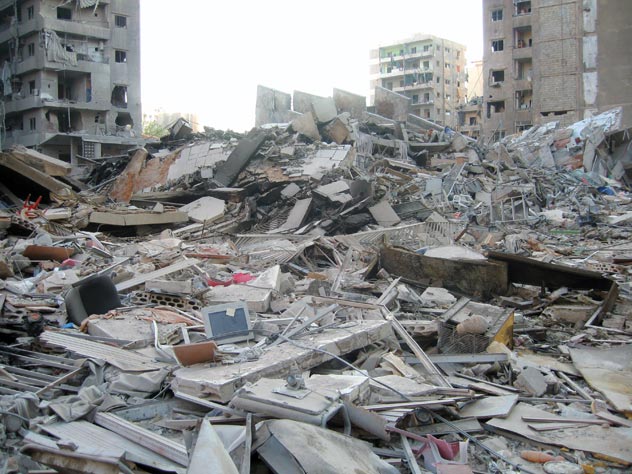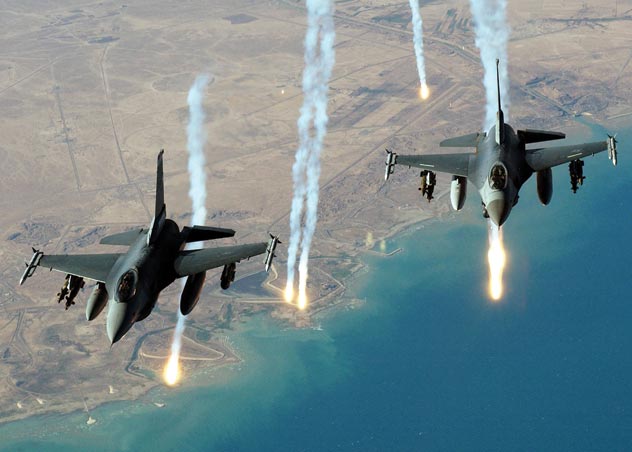GEOPOLITICS:
Make the Rubble Bounce: The Barbarity of Aerial Bombing
Behind the seductive, surreal images of “smart” bombing lies a darker, ugly truth — the terrible human toll taken by bombing air raids. This story of barbarity is largely covered up by the Western media in its selective and distorted reporting and in any case, bombing from the air begs to be classified as a war crime, writes Radhakrishna.

(Above): The real toll of bombing, seen up close, among the detritus strewn after a U.S. attack on Iraq.
This is a common experience in many countries today — a couch potato leans back watching television in the living room when the unexpected happens — without any warning the street explodes, the house caves in, and people wail, some of them crawling, wounded and bewildered in the rubble of broken walls and buildings. Power and water are off, the markets lie destroyed, and houses are open, as a sea of sewage spreads through the city. These unfortunates are at the receiving end of yet another attempt at regime change by a distant, benevolent power.
The first bombs were dropped near Tripoli by the Italians in 1911 and since then the technological progress of aviation has made remarkable strides. Thirty four year later, armadas of B-17s and B-29s, consisting of about a thousand planes, were bombing Germany and Japan. The midnight raids on Tokyo, March 10, 1945, killed more than 90,000 people and carved out an expanding X of flames in the residential and highly inflammable city for four days, without the loss of a single plane. Civilian deaths were about 900,000 in Japan, and about 600,000 in Dresden and other cities in Germany. On Aug. 6, of course, one plane, the Enola Gay, and one bomb,“Little Boy,” killed about 120,000 civilians.
Military air power had come of age. It is best at causing collateral damage when civilians and civilian facilities are deliberately targeted. In 1937, people were still sensitive enough to experience a sense of shock at this deliberate barbarity. Picasso’s famous painting Guernica protested Nazi German and Italian bombings of the Basque town in Spain. Air power was still considered barbaric, and later in 1937, Roosevelt condemned the Japanese bombing of Chinese cities. Ominously for the strategists of air power, it was already noticed that the will to fight was not noticeably diminished.
World War II began with the Nazi bombing of Warsaw, followed by the terror bombing of Rotterdam, and the Blitz against England which killed tens of thousands of British civilians without breaking their will. Nor did the air attacks on Stalingrad in 1942, where about 40,000 were killed. The Allied air offensive against the Germans was much more massive.

(Above): F 16 Fighting Falcons fly over Iraq during a bombing campaign.
The next phase arrived when it became clear that U.S. industry could design, and mass produce planes with more fire-power in greater numbers than any other country. Failed British strategies of precision bombing of military or supply targets like oil depots were replaced by area bombing to target civilians and cities.
Much of the Korean peninsula, including Pyongyang was reduced to rubble. After the Plaine des Jarres in Laos was bombed “back to the Stone Age,” in the 1960s, Hanoi and Haiphong were terror bombed in Christmas 1972 to extract concessions from the North Vietnamese engaged in peace talks in Paris.
More recently, Bush I ended the First Gulf War with a ”turkey shoot,” bombed Afghanistan in 2001, and Bush II ”shocked and awed Baghdad” in 2003. The bombing of Fallujah and the old city of Najaf did not even attract much media attention.
The doctrine of strategic bombing has several advantages. Civilian and military personnel are blurred into distant ant-like hordes, and vital civilian facilities like power and water supplies, hospitals etc, can be taken out to ” break the will of the victims” a procedure that is relatively cost-effective.
In Vietnam, a new twist in the form of Agent Orange polluted the land. B-52 bombers unseen and unheard, dropped 8 million tons of bombs from great heights on Vietnam between 1965 and 1973, or 300 tons per person. For comparison, 2.7 million tons were dropped by the Allies in Europe in World War II and 656.4 thousand tons in the Eastern theatre. Cambodia alone received 2.757 million tons.
Incendiary gels like napalm that stick and burn, ignited by white phosphorus, and anti-personnel pineapple bombs, 250 metal or plastic pellets in each ( undetectable by x-rays, manufacturer GE ) were used. About 250,000 of them were spewed per strike.
A major objective was to maim, since care of the injured is more disruptive than burial.
In 1952, President John F. Kennedy approved Operation Ranch Hand, permitting defoliation of more than a million acres, using Agent Orange,(dioxin), and Agent Blue, millions of liters of which caused serious birth defects, reported even recently in 2003.
This kind of war watched on TV screens in entertaining Technicolor videos provided by the media ( CNN, anyone ?) has the surrealistic sound and beauty of leaping red flares, smoke and immense crashing walls of masonry and ensures passive desensitization of protest among the audience.
The risk to the actual attackers is in any case minimal, and is being reduced further by remote operation. One summary of a single day of operations reads ” In total, coalition aircraft flew 46 close-air support missions for Operation Iraqi Freedom.” Bombs of up to 2,000 lbs each are dropped regularly, often in urban areas.
Better technology is on the way. Predator drones over Iraq, armed with Hellfire missiles, allow the ”couch” warrior to deliver not-so-precision strikes from 7,000 miles away, in the Nellis Air Force Base near Las Vegas.
The same technology is used by the Israelis in remaking Lebanon and other areas in the Middle East. Power plants, factories, water and sewage plants, apartment complexes, telecom facilities, and families fleeing in cars or minivans are all legitimate targets.
It is all very well to repeat that these campaigns do not break the will of the targeted people, on the basis of a few, weak retaliatory responses. But attrition techniques do work. Where are the Jews in Poland today ?

(Above): “Guernica.” Pablo Picasso, 1937. The Spanish government commissioned Picasso to paint a large mural for the Spanish display at the Paris International Exposition (the 1937 World’s Fair in Paris). Picasso, outraged by the Nazi attack on the Basque town of Guernica, drew the mural in 15 days. Twenty-eight bombers, on April 26, 1937 during the Spanish Civil War, killed between 250 and 1,600 people. “Guernica” epitomizes the tragedies of war and the suffering war inflicts upon individuals, and it has become an anti-war symbol.
In 1967, Mary McCarthy has recorded the stolid conviction of the pilots on the nuclear carrier ”Enterprise” that they never, ever bombed anything but military targets, selected by computers working on aerial photographs, and ”post-raid reconnaissance” recorded on film eliminated the possibility of error. She comments on the incongruity of the use of anti-personnel fragmentation munitions, and cluster bombs, in such cases. Who was in error — the journalists who snapped photographs on the ground or the unmanned cameras of the U.S. Navy ?
In a few cases there have been personnel who are not completely desensitized. In the last days of the Vietnam War, when the discipline of the armed forces was unraveling, Capt Dwight Evans and Capt Michael Heck refused to fly during the so-called Christmas bombings of civilian targets in North Vietnam. Heck, on his fourth combat tour, had flown 262 bombing missions, and is quoted — “The goals do not justify the mass destruction and killings” ( New York Times ,Jan. 11, 1973, A1, and Jan. 20, 1973 ). Four other airmen refused to fly combat missions on B52s, and sued the Pentagon. Pilot Richard Dawson went to court, claiming that the Cambodian war was illegal, a claim upheld up to the Supreme Court. Charges were then dropped. (NYT June 6, 1973, A10 and NYT July 26, 1973, A1)
In this story of barbarity, the sinister role of the media raises questions about its selective and distorted reporting. The individuals and the corporations who own and control the media have much to answer for. In any case, bombing from the air begs to be classified as a war crime and should be immediately outlawed by international agreement, or agitation.
|